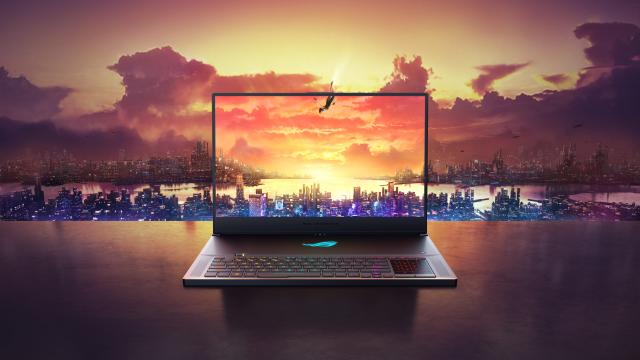When RTX Super graphics cards arrived for desktops, they provided a great ‘middle-option’ for people who wanted to get the most frames for their budget. The RTX 2060 Super, in particular, kind of made the RTX 2070 obsolete, not because the hardware itself was outdated, but because the RTX 2060 Super had the same amount of power at a cheaper price. It was, and still is, the best ‘bang for your buck’ option with ray tracing when it comes to desktop GPUs. But don’t expect to see an RTX 2060 Super as part of Nvidia’s latest mobile GPU lineup.
Only the RTX 2080 Super and RTX 2070 Super are coming to laptops sometime this month. I can’t say for certain why Nvidia is opting to release mobile versions of only those two cards, but new RTX 2060 laptop models will be available instead. Nvidia is also introducing a new and improved version of its Max-Q technology, which will be available in some new RTX 2080 Super, 2070 Super, and 2060 laptops. They’re also getting Intel’s Core i7 and Core i9 10th-gen mobile processors that were announced today, too.
But the thing that raises my eyebrows is Nvidia’s suggested entry price for new RTX 2060 laptops—$US1,000 ($1,647). Currently, laptops with a GTX 1660 Ti hover around that price right now, depending on other specs. Laptops with a RTX 2060 price well over a grand currently, so for Nvidia to say that laptops with its base ray tracing card will be available in the not too distant future for hundreds of dollars less is pretty bold.
According to Nvidia’s RTX Studio page, every RTX Studio system (desktop or laptop) comes with at least a: GeForce RTX 2060, Titan RTX, Quadro RTX 3000, or higher; Intel Core i7 or equivalent, or higher; 16 GB or more; 512 GB SSD or more; and a 1080p or 4K display (laptop or all-in-one). There’s no word yet on how these new laptops will be configured, but to get that large of a price drop typically means a step down or two in processing speed, available storage, and/or amount of memory. The Acer ConceptD 7, for instance, is currently priced at $US2,300 ($3,788) on the page—far from that $US1,000 ($1,647) price point—and it comes with an Intel Core i7-9750H processor, RTX 2060, 16GB DDR4 RAM, and a 1TB SSD. I’m assuming that all-new RTX 2060 laptop models won’t have a 10th-gen Intel processor in them to keep costs down.
But some OEMs seem to be taking the $US1,000 ($1,647) price to heart. Lenovo says its Legion 5i (previously the Legion Y540) with a RTX 2060 GPU will be available starting at $US1,000 ($1,647). Whether that is paired with a 10th-gen Intel mobile CPU, or any other sweet hardware components like a 1TB SSD, remains to be seen. It didn’t provide specific configuration details.
Acer also said is new Nitro 5 gaming notebooks will come with up to a RTX 2060, with a starting price of $US750 ($1,235). Although, I suspect that low of a price has a GTX 1650 or GTX 1650 Ti instead. Both Nitro 5 and Predator Triton 500 laptops will include Intel 10th-gen mobile CPUs, too. Acer did not provide specific configuration details, either.
Moving on to Max-Q 2.0, one of the new features, Dynamic Boost, provides “automatic, per-frame GPU and CPU power balancing,” meaning, hopefully, more power is delivered to the GPU or CPU as necessary, depending on what kind of resource a games or program uses the most. (Some are GPU heavy, while others are CPU heavy.) According to Nvidia, this gives games about a 6 to 9 per cent boost in performance. While a Max-Q laptop with a GTX 1080 from three years ago might get you an average of 73 fps on high, with ray tracing off, on games like Control, Wolfenstein: Youngblood, or Deliver Us The Moon, a Max-Q laptop with a RTX 2080 Super will average 167 fps with the same games on the same graphics settings, claims Nvidia.
On paper, this seems like it could help with the drop in framerate that ends up happening with current Max-Q laptops. They’re slightly less powerful than their regular siblings because they’re designed for efficiency over performance; higher framerates mean higher clock speed and voltages, which means more heat output and chunkier laptops.
But Max-Q makes high-end laptops thinner, lighter, and quieter, which is kind of the ‘in thing’ these days. Dynamic Boost isn’t something that will become available to first-gen Max-Q laptops because it’s something specific to the new design. We’ll hopefully get our hands on some of these new laptops soon and see if the new Max-Q design really does have better fps performance. But we’ll continue to lament the lack of a mobile 2060 Super too.
Editor’s Note: Stay tuned for Australian pricing and availability for these products.
